Thanksgiving Cactus Care
The colorful blooms of the Thanksgiving Cactus can be hard to resist during the holiday season.
Thanksgiving cacti, also known as Schlumbergera truncata, are a tropical plant that hail from South American jungles. The flower buds of this bright beauty come in a variety of pinks, creams, oranges and reds.
As the name implies, this vibrant plant blooms beautifully right around Thanksgiving.

Let me just interject…. beautiful bold colored blooms during winter are a must in some parts of the world! They brighten up our winter drear and bring immense joy. Thank you, cacti! I digress…
Holiday cactus make wonderful gifts and add a splash of color to holiday decor. Thanksgiving cactus, especially, bring vibrancy to the winter months. But there’s much more to this holiday bloom than what meets the eye!
Today we are sharing everything you need to know to grow and care for one of these unique holiday cactus plants yourself.
This post contains affiliate links. If you click through and make a purchase, we may make a small commission at no extra cost to you.
About
Thanksgiving cactus plants are a tropical plant that bloom in cooler temperatures. When we think of cactus we often think of dry deserts, little water and heat.
But this vibrant bloomer is a tropical plant, native to South American jungles, where life is shaded and cool. As such, these cacti crave indirect light and cool temperatures to bring out their prolific blooms!
Thanksgiving cacti are often called by the common names crab cactus or crab claw cactus due to their pointed leaf shape. They are part of a small genus of cactus called Schlumbergera.
(Differences between Christmas and Thanksgiving cactus are shown here).
Several different plants from this genus are commonly grown in the US from this region, and are differentiated by the time of year in which they bloom, and their leaf and flower shape.
Christmas cactus and Easter cactus are two similar cactus beloved in the US. They bloom as their name indicates, around Easter and Christmas, although depending on the specific growing conditions, bloom time can range.
(Sources: North Carolina State University)
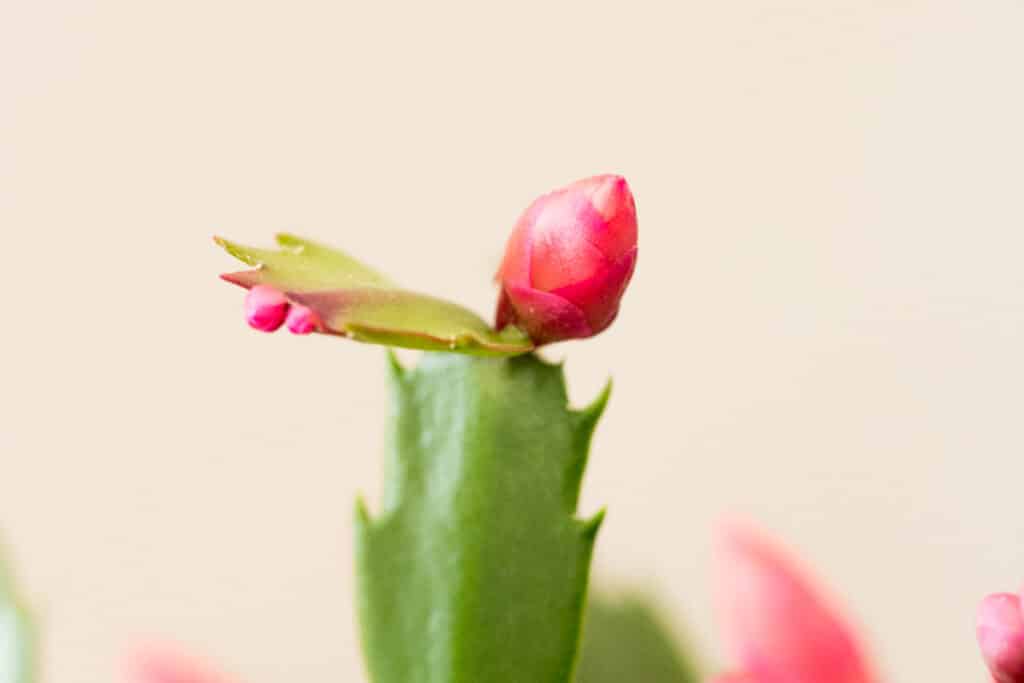
Thanksgiving cacti grow in the coastal mountain regions of Brazil and make their homes in rocks and trees. They are an epiphyte, which is a plant that that roots on another plant or plant debris, such as a tree. (Similar to an air plant).
They have a shallow root system and need loose, well draining soil to prevent too much water from sitting on their roots.
The natural environment is shady with moderate temperatures. In the wild, holiday cacti grow on a woody base and can grow 4 feet tall.
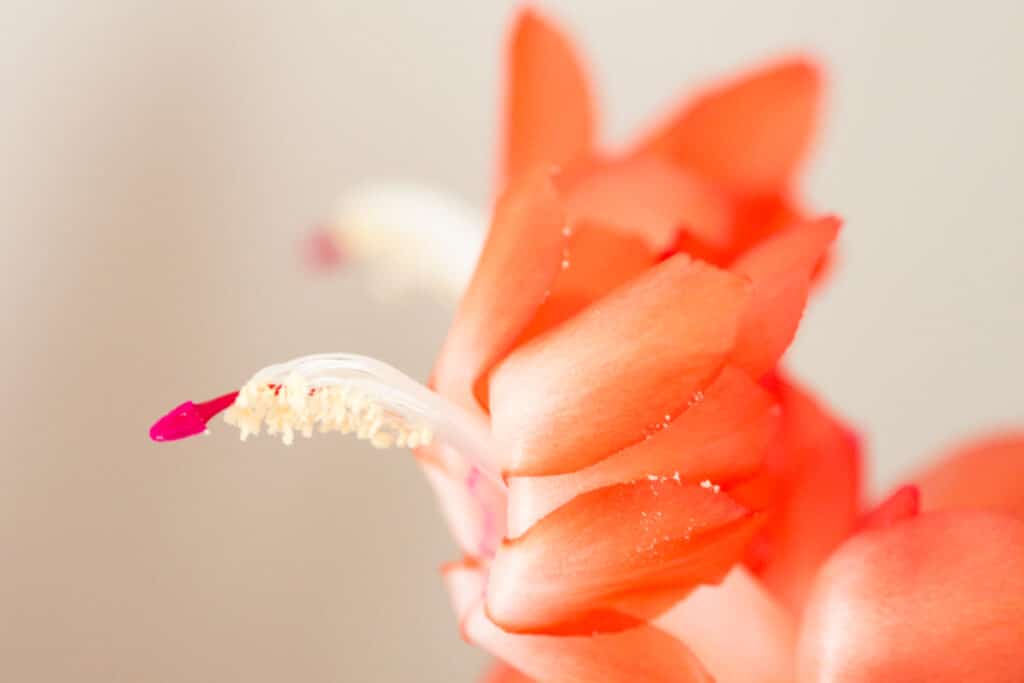
The plant is composed of green stem segments which act to absorb light and perform photosynthesis. The flowers hang downwards or horizontally and have tepals that are tubular in shape and curve backwards towards the base of the plant.
When in bloom, they look like a beautiful firework display.
Thanksgiving cactus are available in a variety of colors and can be purchased at garden centers and grocery stores during the holiday season. They make a savvy gift for your Thanksgiving host, or a gift for a family member. (I bought one for my mom last year!)
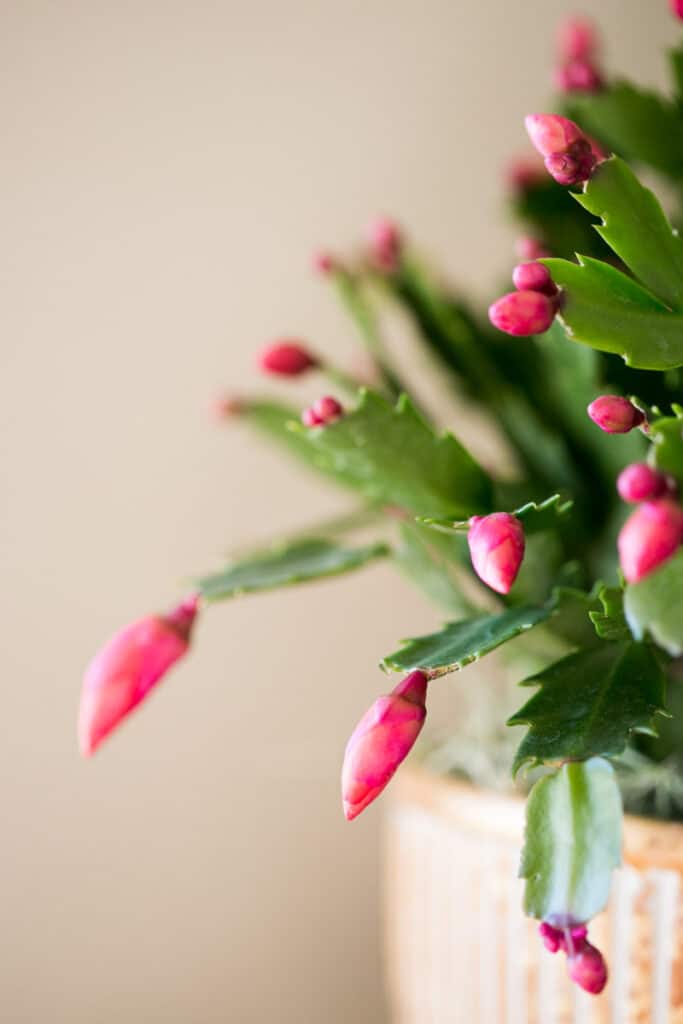
Care
Give these unique holiday plants bright, indirect light and use soil that is kept moist but well draining. Make sure you have adequate drainage holes in the bottom of your container before potting or re-potting.
We go in depth on soil, water, and light requirements here:
Soil
Thanksgiving cactus grow best in loose, slightly acidic, well draining soil that has good aeration. Heavy potting mixes that stay damp and do not allow draining can kill the plant.
Perlite, a lightweight material made from volcanic ash, can be added to the potting soil and will add drainage and aeration.
Orchid bark is an excellent soil add in that adds additional nutrients and drainage.
In their natural growing environment Thanksgiving cacti are surrounded by decaying matter in the form of leaves and plant debris, which creates an acidic soil. A pH range of 5.5-6.2 is ideal.
Overly moist soil will encourage fungus and rot to grow, and attract fungus gnats. Good drainage is absolutely essential!
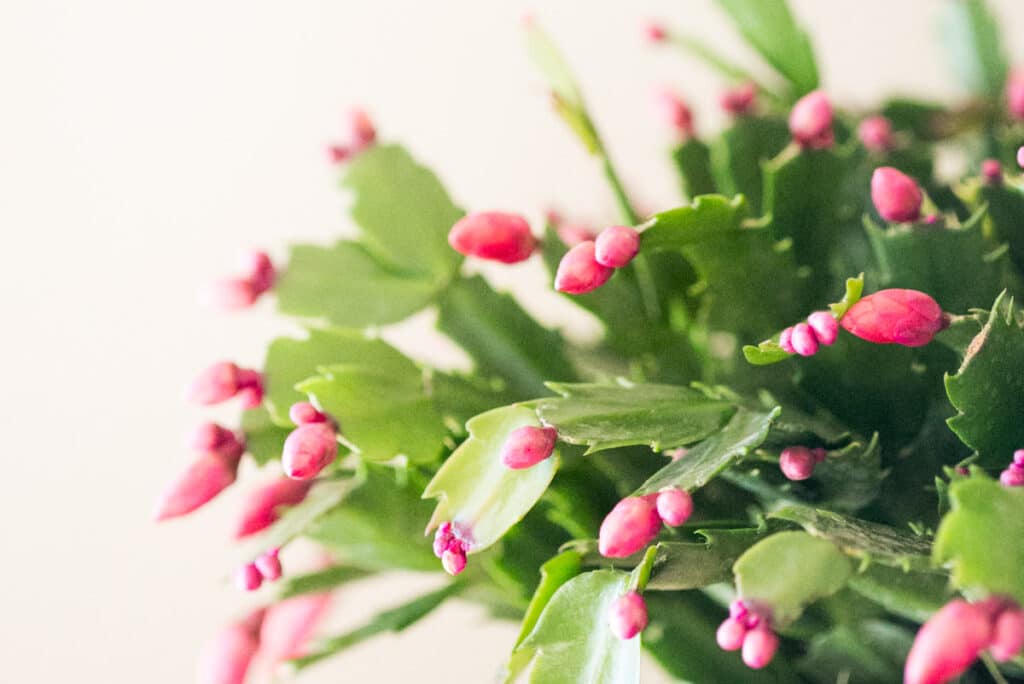
Water
Typically speaking, your cactus will need to be watered once every week to two weeks.
When the top layer of soil is dry water your cacti deeply, allowing the water to drain out of the bottom of the pot. (Don’t drown your plant, use good judgement!). Then wait until the top few inches of soil are dry before you water again.
Well-draining soil must go hand in hand with a good watering schedule!
The specific environment you live in will affect the watering needs of your plant, however. A plant growing in a humid climate will need less water than one growing in a dry climate. Seasonality will affect the plant’s need for water as well.
Get our guide to the best water source for houseplants right here!
You can tell that a Thanksgiving cacti is thirsty and needs to be watered when the top two inches of the soil is dry to the touch, or you can use a soil moisture meter.
Always use a gentle stream of water and apply at the base of the plant. We love using this watering can that has a long spout-specifically made for indoor plants.
Great soil drainage and proper water amounts are key to key to keeping a Thanksgiving cactus happy and healthy.
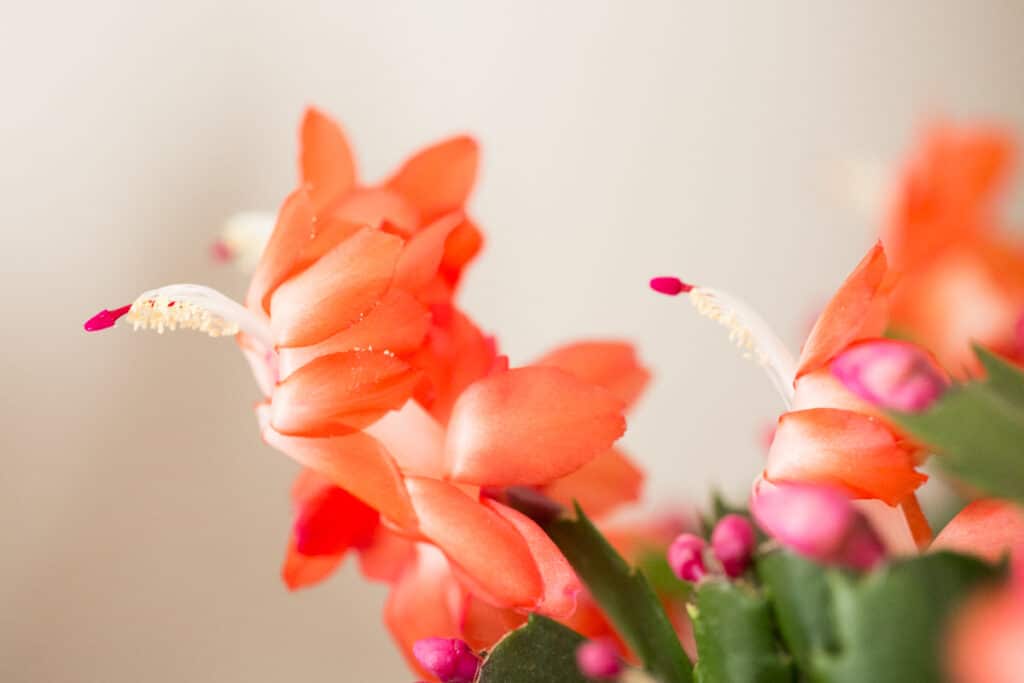
Light
Remember that Thanksgiving cactus are native to the jungle and receive a lot of bright, indirect light in their natural habitat.
This same bright but indirect light in the home is essential for crab cactus to produce blooms. Pick a spot that is well lit but has no direct sun beams that will fall on the flower.
Harsh sunlight can burn the leaf segments and damage the plant. Purple leaves are often a sign of too much direct light.
Long nights are needed for buds to set in the fall (at least 12 hours of darkness).
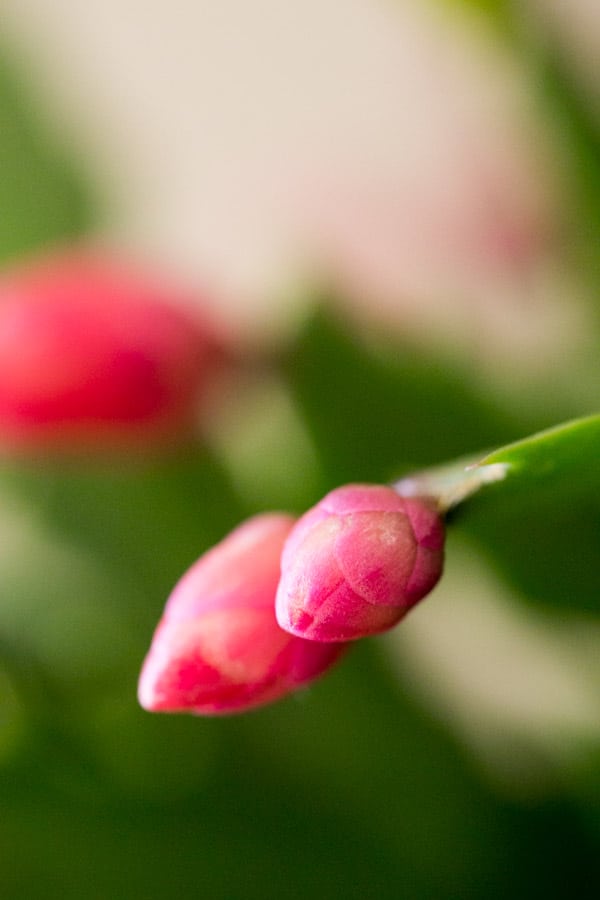
Humidity
The tropical region that Thanksgiving cactus naturally hail from is full of humidity. When grown as a houseplant, these succulents will be happiest with a humidity level of at least 40-50%.
You can naturally increase humidity levels by running a humidifier, like this one. Or, you can set your plant near a bathroom or a kitchen with frequent running warm or boiling hot water.
I have personally had success keeping my holiday cacti in a bedroom that is adjacent to our frequently used bathrooms. All the bathing raises the overall humidity in the atmosphere!
Bloom Appearance
Thanksgiving cactus give an absolutely stunning bloom available in pink, red, white and cream tones.
The medium sized buds grow from areoles at the tips of the stem. The flower tepals (which look like the petals), unfurl backwards toward the plant, then begin to fuse together towards the end of the flower, forming a tube.
There is a cluster of long, brilliant stamens bursting forth from the center of the tepals. The pollen at the end of the stamens is a light yellow color. (Christmas cactus have pink pollen!).
The bloom is incredibly festive, reminiscent of a beautiful holiday ornament.
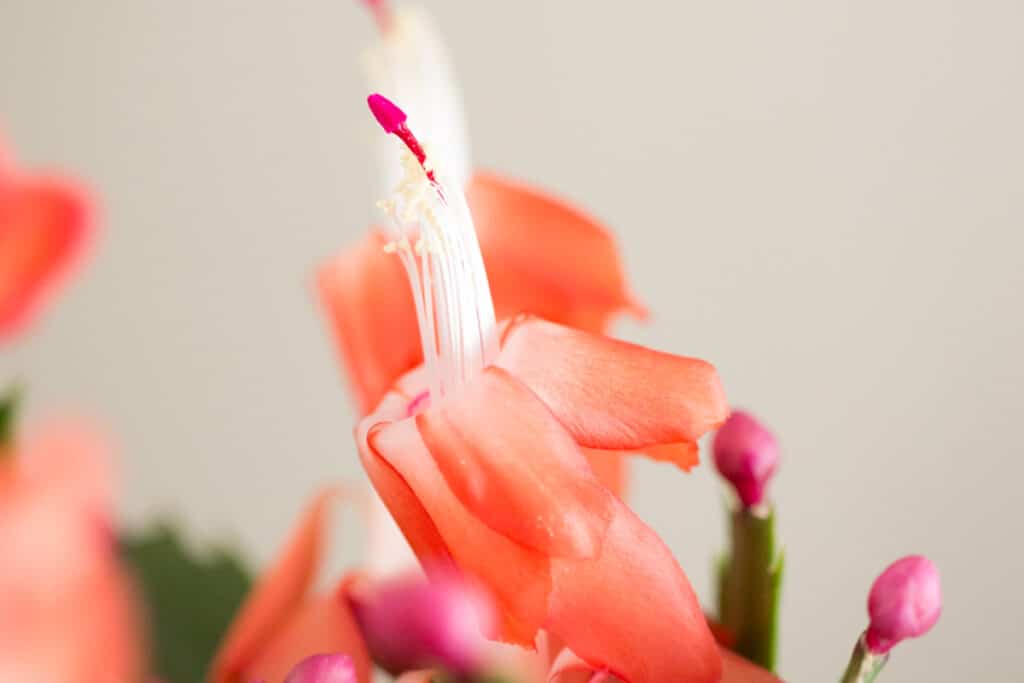
Bloom Time
Thanksgiving cactus bloom in late fall, right around the time of the holiday in November. When a plant is purchased right before the holiday the buds will already be set.
Blooms can last up to 8 weeks if properly cared for. Optimal temperatures are between 68-70 degrees, use care with watering, and keep the plant out of direct sun.
However, the following year you will have to create the right conditions for your cacti to bloom in. You will need to try to limit the light that the plant receives (many growing zones are conducive to this, and you may not need to anything).
*Do not fertilize or re pot while the plant is blooming!
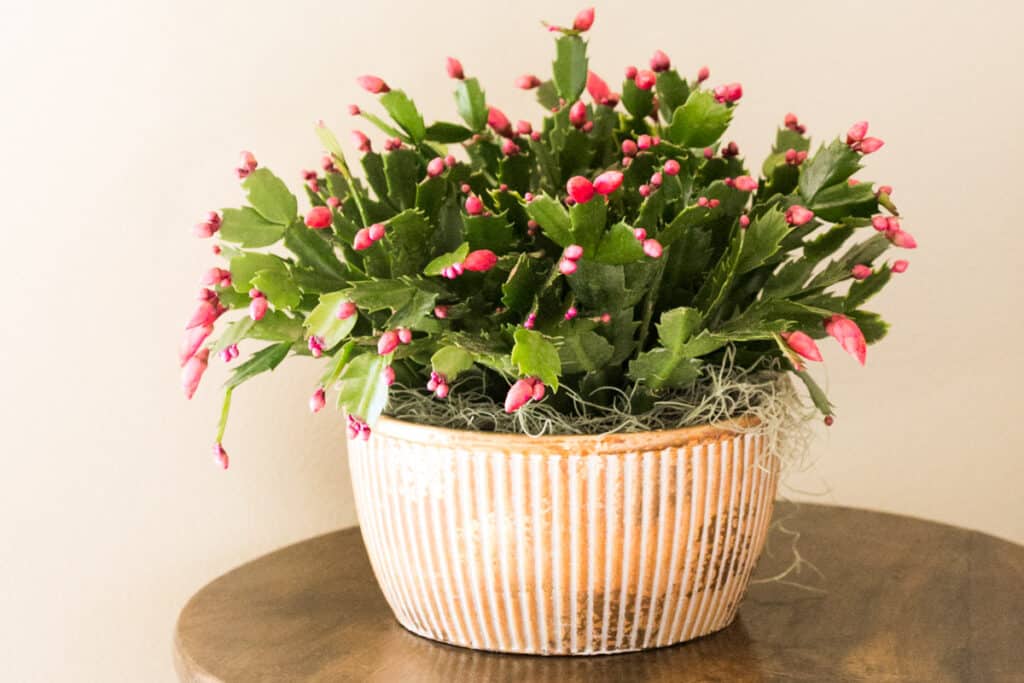
How To Get Thanksgiving Cactus To Bloom
Holiday cactus are short day plants, which means that they need long hours of darkness and shorter daylight hours for 6 weeks in order to set their buds.
These cooler temperatures and longer hours of complete darkness are essential for getting a Thanksgiving cactus to bloom. They need 12-15 hours of darkness. You may need to “trick” your plant with artificial darkness to get it to set buds.
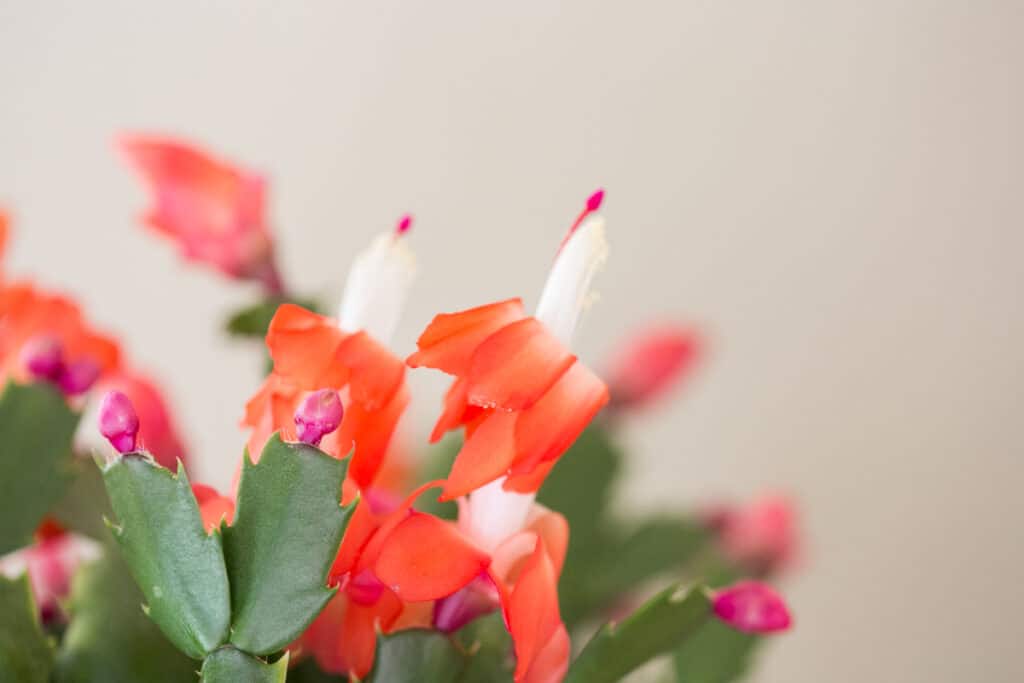
To do this you can carefully place your cactus is a dark spot for 12-15 hours of continuous darkness. You can place it in a dark closet or cover it with a plastic bag for this time.
Make sure that no light hits the plant during these hours as it will be detrimental to the bloom process!
You can also try setting your cactus outside in early fall when temperatures hover around 55 degrees and longer nights set in.
Once your plant sets it’s blooms, you can bring it out and enjoy the flowering process!
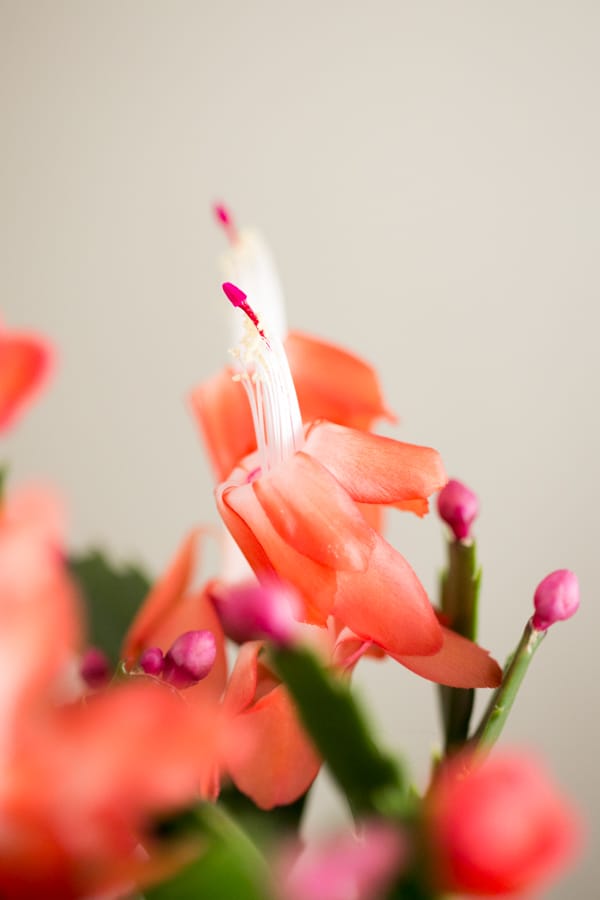
If you’d like to learn how to take up close photos of flowers, read this article!
Fertilizing
When grown in containers, Thanksgiving cactus will eventually use up all the nutrients within the soil.
Because of this, it is essential to fertilize the cactus plant. Use a water soluble fertilizer with a ratio of 20-20-20. Fertilize in early winter and spring, and stop when bud production starts in late summer and fall.
While Thanksgiving cactus like to be root bound, you do need to replace the soil every few years as the nutrients are consumed by the plant.
How Long Can Thanksgiving Cactus Live?
Thanksgiving cactus can live up to 100 years! With proper care, Thanksgiving cactus can live for decades… we have a friend with a 40 year old plant.
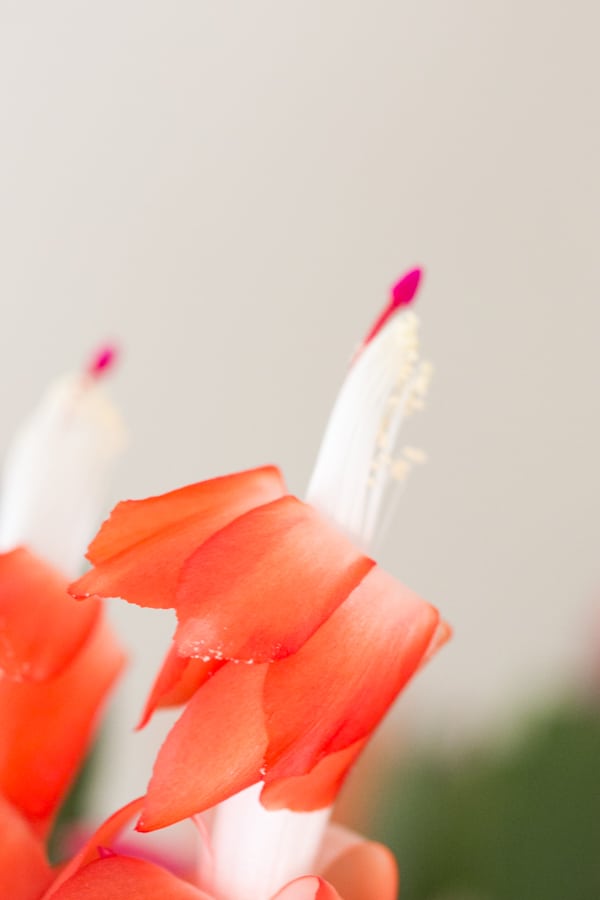
Propagation
Growing new plants from a holiday cactus is incredibly easy. You can take stem cuttings from your established plant, place them in potting soil, and roots will grow rather quickly!
The best time to propagate new plants is after the plant has stopped blooming. You can combine pruning with propagating new plants.
Step By Step Guide For Propagating Thanksgiving Cactus:
- Gather small plastic containers such as discarded yogurt cups and add drainage holes to the bottom (make sure they are clean)
- Fill with a loose, well draining potting soil
- Water the soil well until the water begins to run out of the drainage holes
- A cutting is simply a cacti stem that is about 4 segments long. Twist off a cutting at the joint of the 4th segment
- Prop the cutting into the soil and water well once again. Make sure the cutting is standing straight up
- Place in a warm room in indirect light
- Keep soil moist for several weeks as the cutting develops roots
*In lieu of soil you can use vermiculite mixed with potting soil.
**Some gardeners allow the bottom of the cactus become callus by setting it out to dry for a week prior to planting.

If your plant cutting remains stiff and firm, it is a good sign that it is thriving and creating new roots.
Growing new plants from cuttings should be fairly easy, as Thanksgiving cactus naturally grow and adapt new aerial roots on debris and trees in their native habitat, and should not be high maintenance to propagate.
If the cutting is wilted or decayed, however, it can be tossed and the process started again. Making multiple cuttings at one time is a good idea to guarantee success.
If all goes well, you will have beautiful Thanksgiving plants to share with friends and family next year!
Colors
Thanksgiving cactus come in many brilliant colors, and look a bit like a stationary firework display when they are in full bloom! You will find them in various shades of light pink, dark pink, peach, rose, lavender, orange and white.
Thanksgiving Cactus Vs Christmas Cactus
The difference between Thanksgiving cactus and Christmas cactus lies in the shape of the leaf, it’s pollen color, and the bloom time of each plant:
Shape Of Leaf: As the name claw cactus indicates, Thanksgiving cactus have a sharp claw like shape at the end of each leaf. The leaf of a Christmas cactus is more scalloped in shape, with blunted round curves at the end of each leaf point.
Color: The stamen of a Thanksgiving cactus contain a brilliant yellow pollen, while on a Christmas cactus they pollen is pink. The stamen are the long, slender reproductive parts of the flower which contain the pollen.
Bloom Time: Each type of cactus blooms in reference to it’s common name. The Thanksgiving cactus blooms around Thanksgiving, of course, and the Christmas cactus blooms a few weeks later.
You can read our full guide on the difference between the two holiday cacti here.
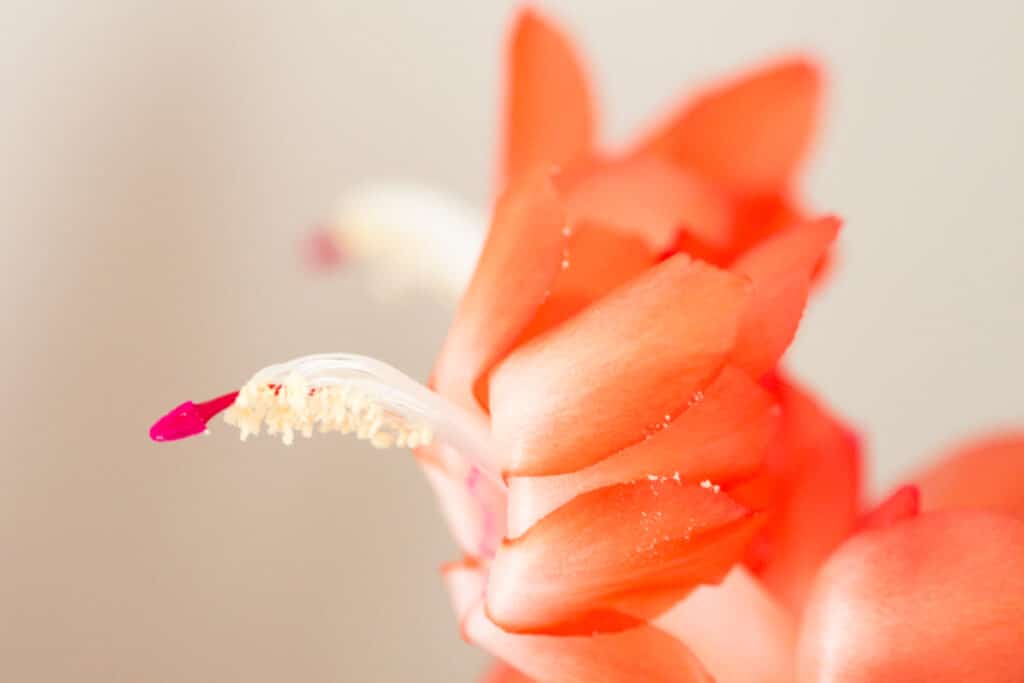
Deadheading
Should you deadhead Thanksgiving cactus?
Yes, as blooms become faded and wilt, you can carefully deadhead your cactus plant. Gently remove spent blooms from the end of the plant leaf.
The plant will not produce new blooms because of deadheading, but it will be able to put all it’s energy into the rest of the flowers!
Alternatively, the flowers will wilt and then fall, and you can just clean them up.
Pruning
Pruning Thanksgiving cactus can be done in late winter after the plant blooms and will encourage branching and new growth, resulting in a larger and bushier plant.
To prune, gently twist of the leaf section where you would like to see new growth.
How Often Does A Thanksgiving Cactus Bloom?
Thanksgiving cactus bloom just once a year, around the holiday in November.
Does Cactus Like To Be Root Bound?
Thanksgiving cactus do like to be root bound, however too tight of growing conditions will eventually contribute to wilting.
If the cactus is overly pot bound, choose a container one size up, with drainage holes and transfer your plant to potting soil mixed with vermiculite.
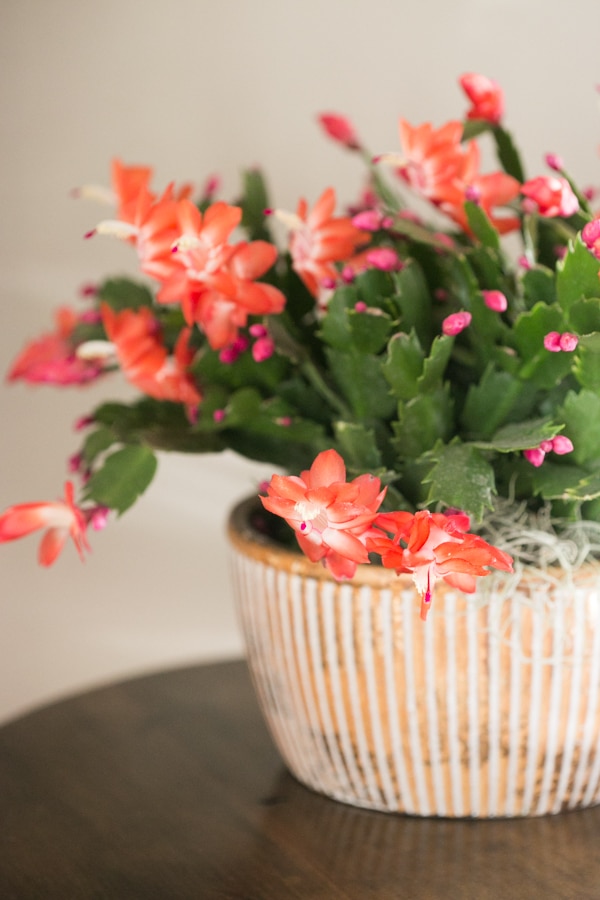
Common Problems
While these tropical plants are generally low maintenance, they can have plant problems from time to time. Here are a common problems and their solutions:
- No Blooms: Remember that the Christmas cactus needs long periods of darkness in order to set buds in the fall. If you cactus does not have blooms, it probably did not get the appropriate light and darkness ratio earlier in the year.
- Flower Buds Falling Off: While generally hardy, Thanksgiving cactus can be sensitive to being moved around frequently or subjected to cold temperatures. Keep the location consistent and the temperatures steady and moderate.
- Yellow Leaves: Yellowing leaves can be indicative of over watering. Let the soil dry out slighting between watering. If over watering is not the problem, the plant may need a bigger pot to give it’s roots some room to expand, or it may need new soil.
- Drooping: Drooping can be indicative of several things: your plant may need a bigger pot, or you may be under watering it. Direct sunlight can also cause wilting of leaves.
- Root Rot: Root rot can be caused by over watering and will kill the plant. To prevent, make sure to wait until the top of the soil is dry before watering, and have proper drainage in your container.
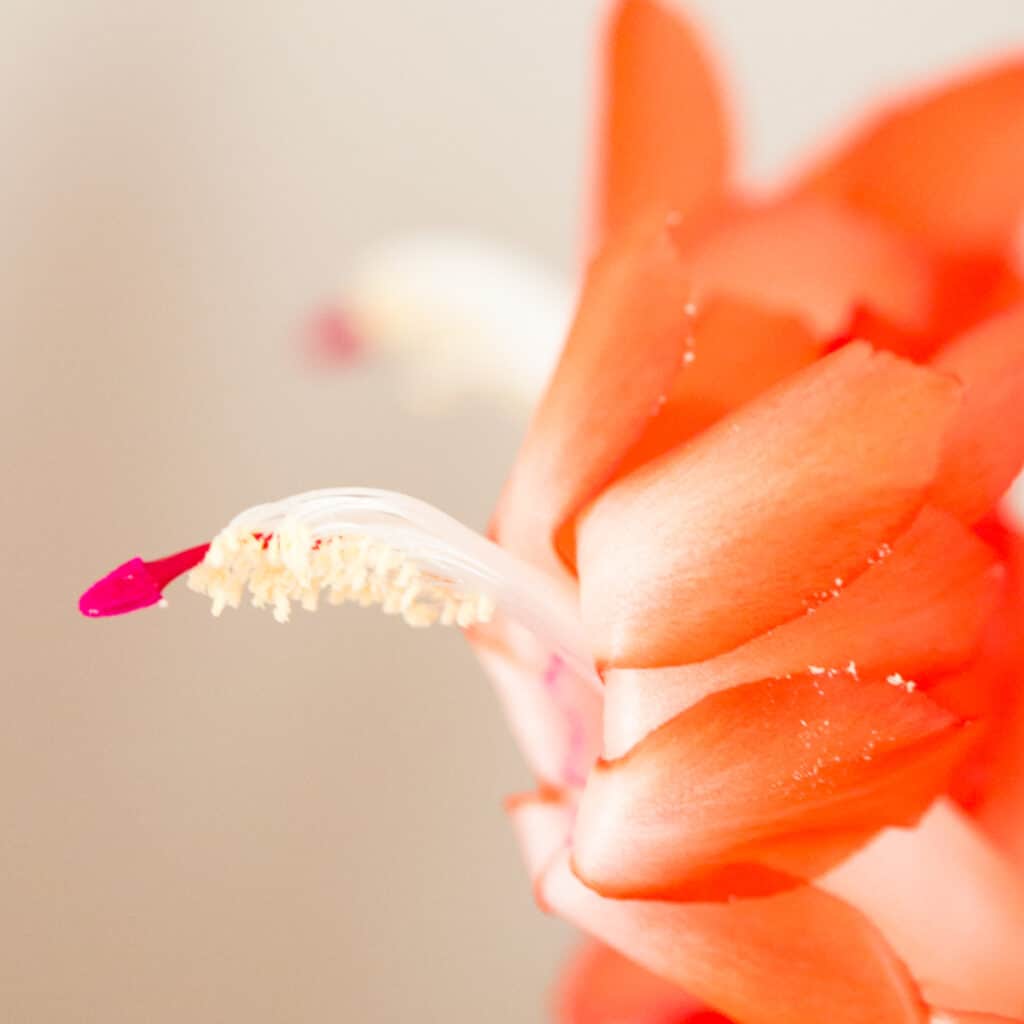
We hope you enjoyed learning all about the magnificent Thanksgiving cactus with us. This brilliant flower is truly a show stopper during the holidays!
Let us know in the comments if you have any cacti questions or concerns.

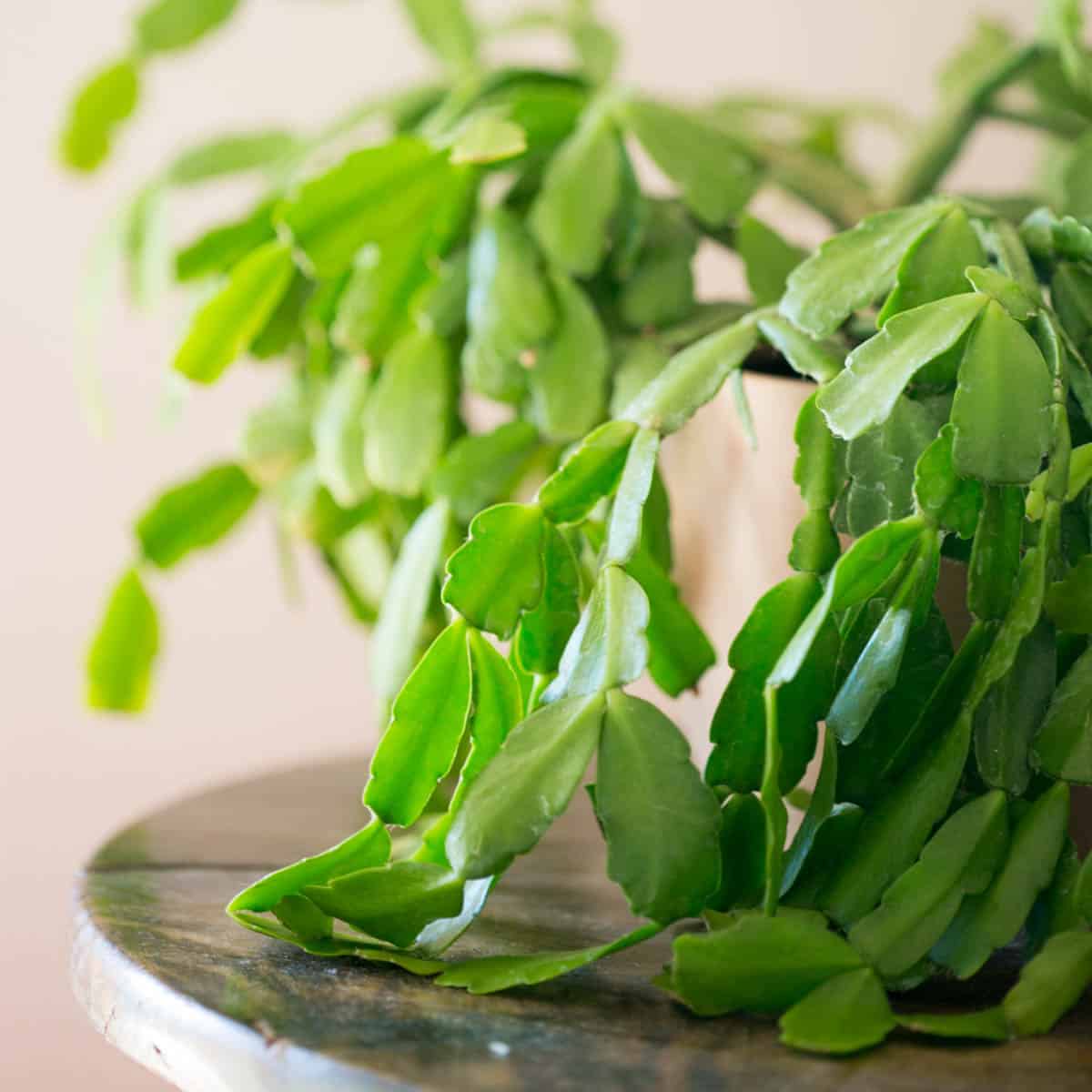
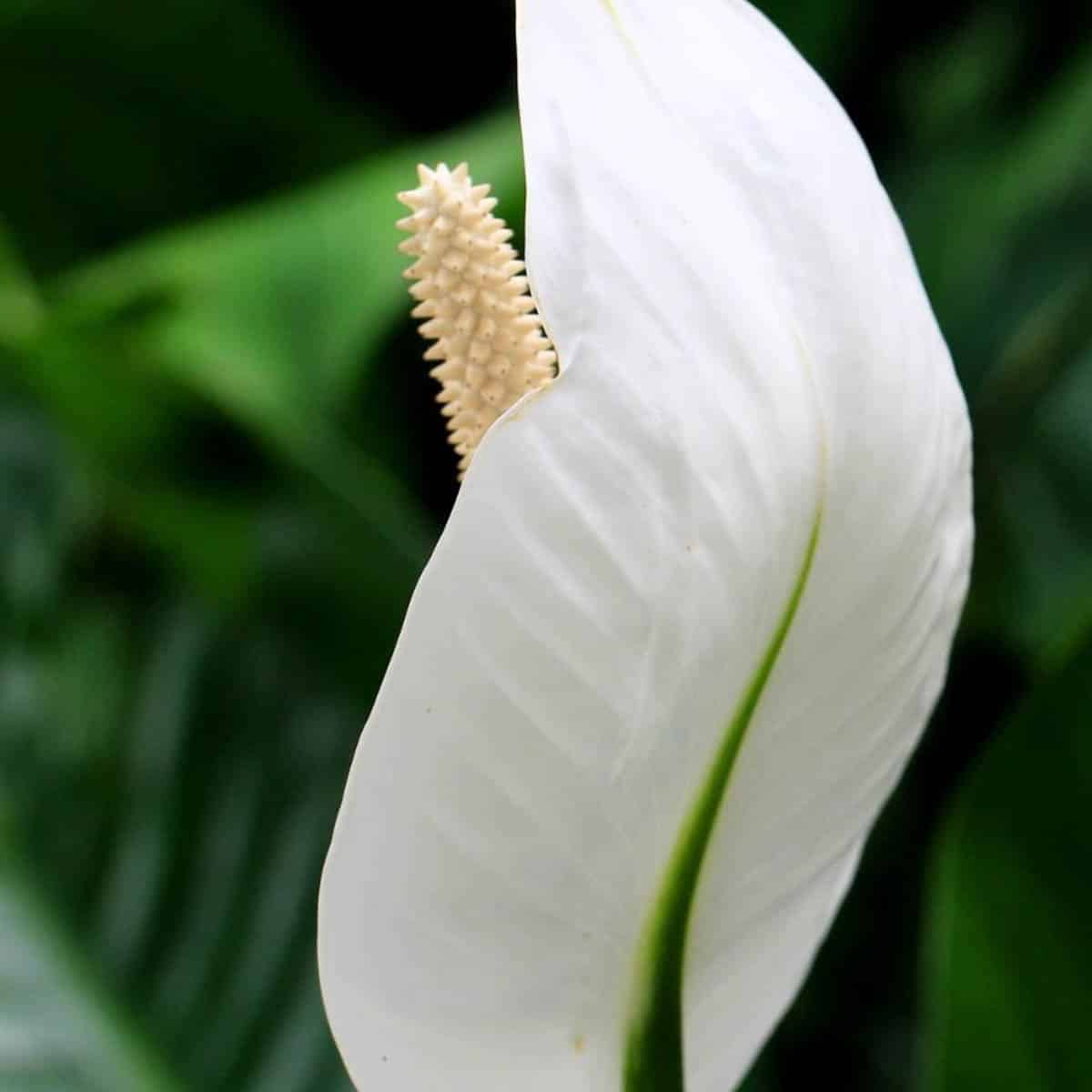
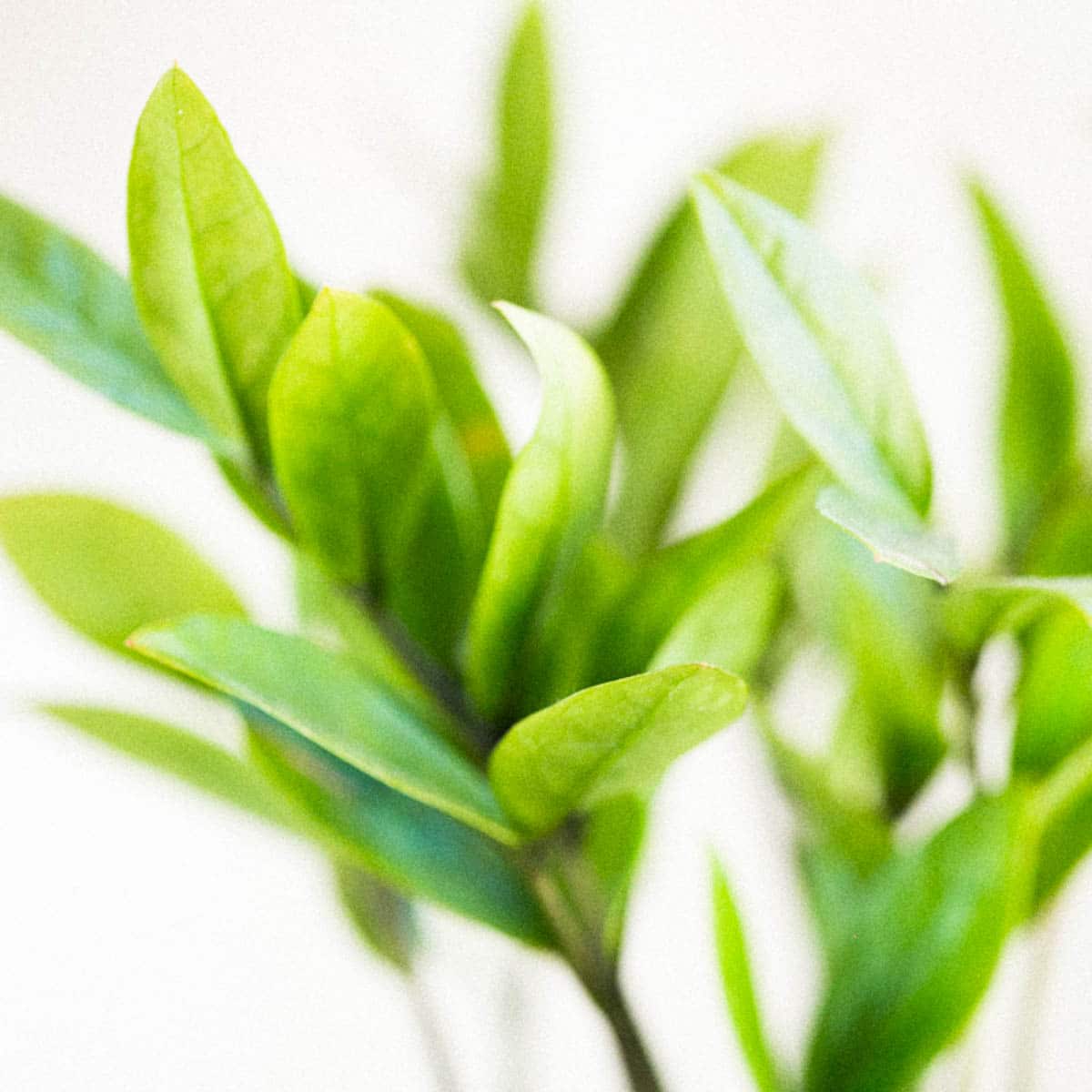
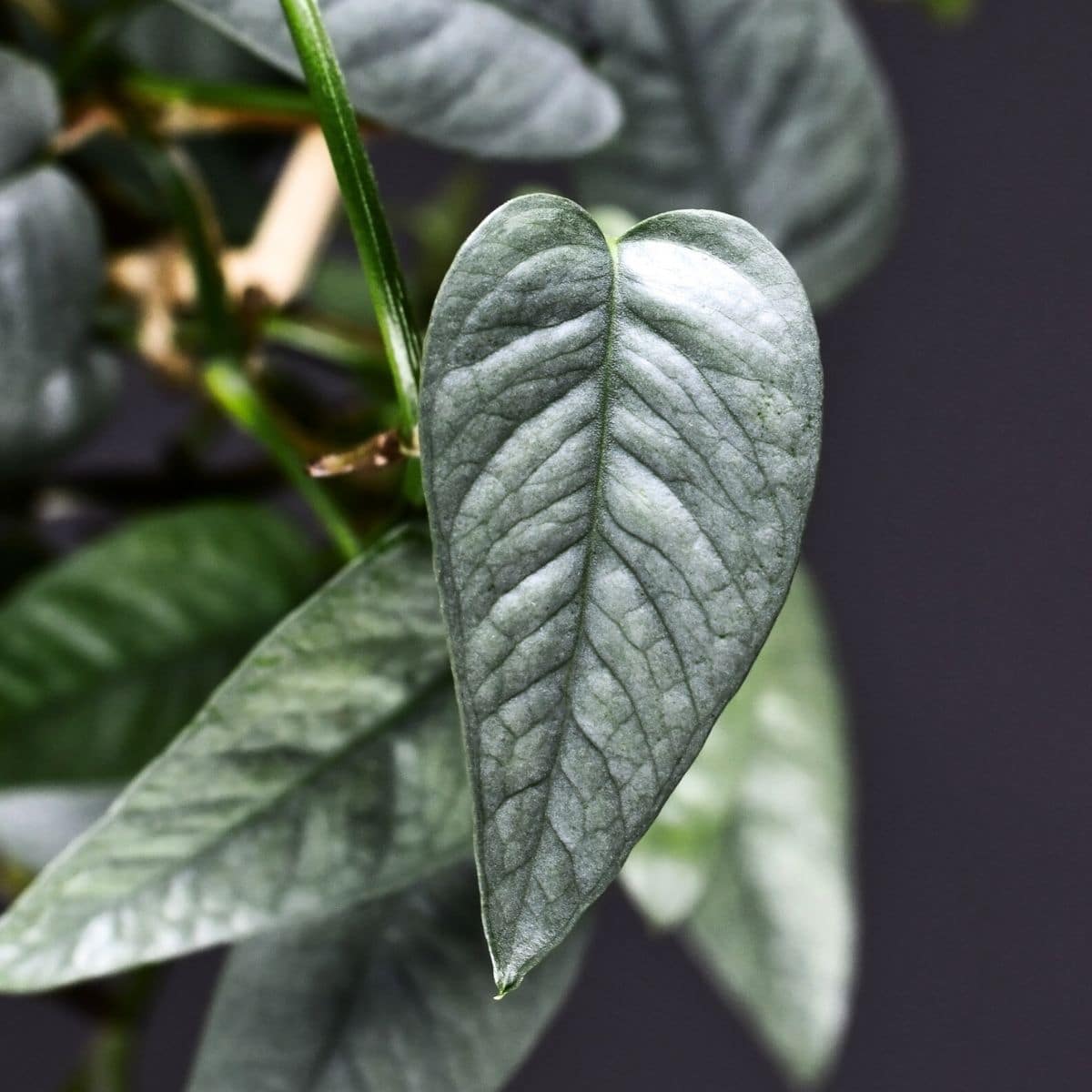
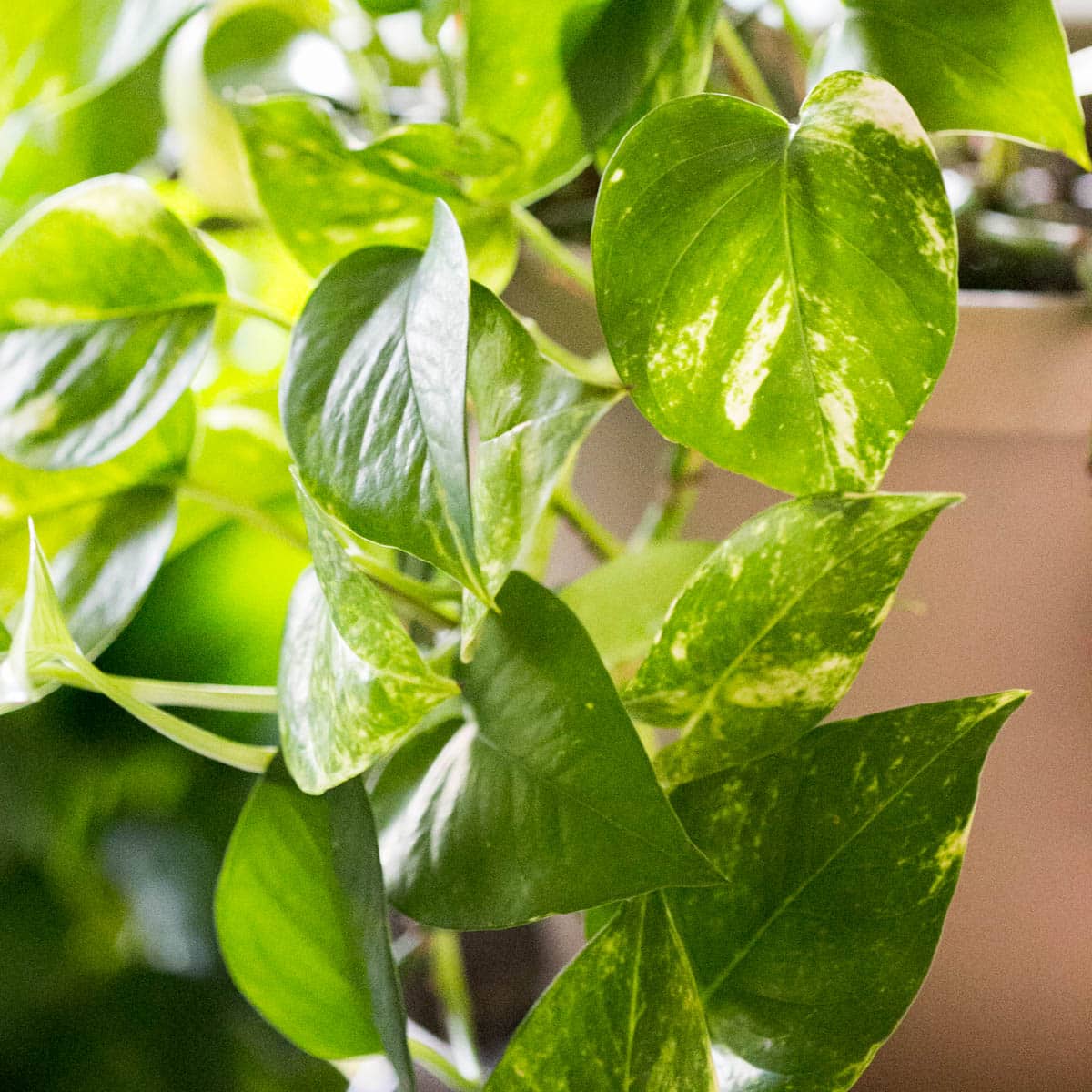
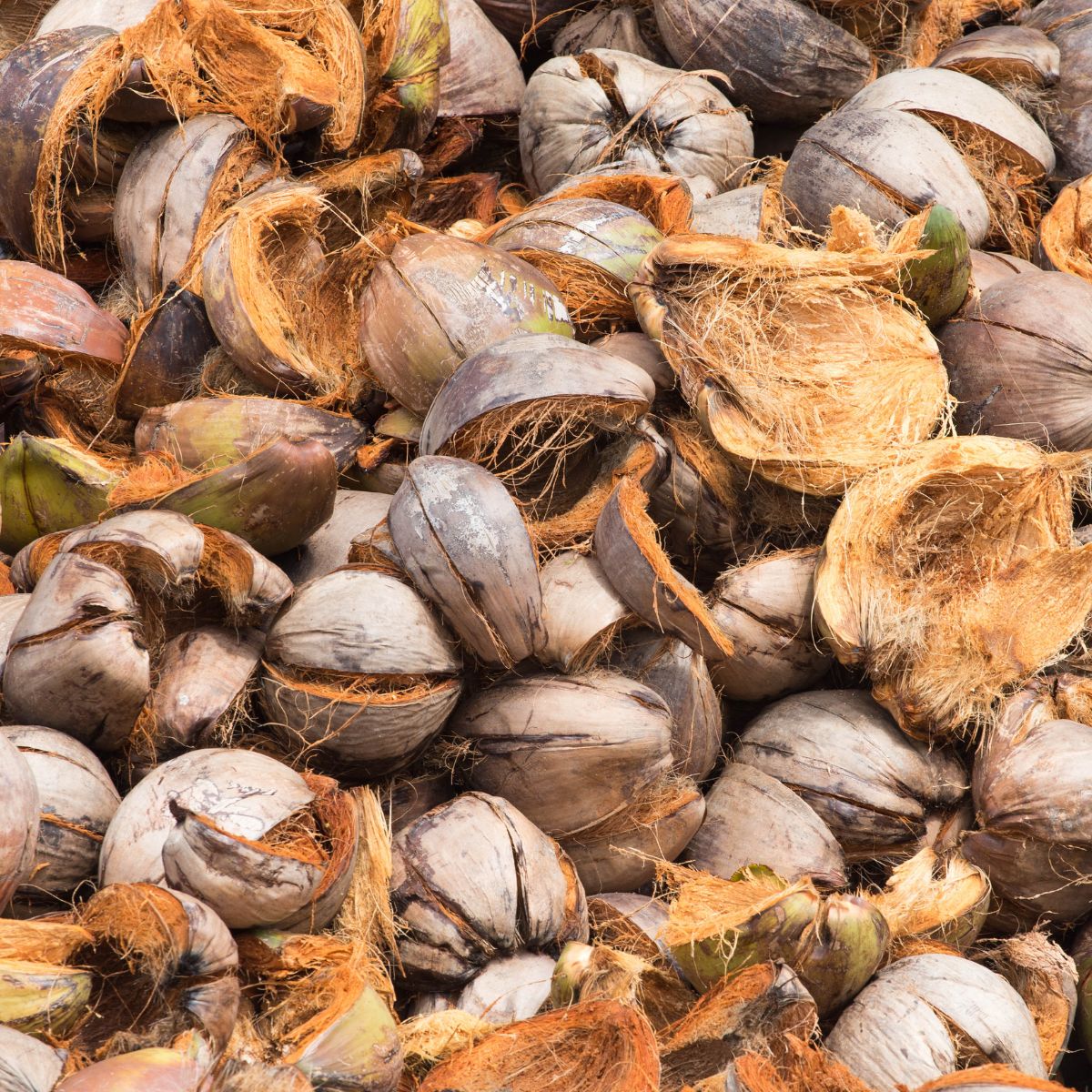
Apparently my Cactus believes it is a Halloween cactus as it started blooming in October hopefully it will last into November.
Mine did not bloom
Last year. Now here it is the middle of October and my Thanksgiving cactus is going to bloom for Halloween! I’m
Sad that it’s early!
Mine too!!!
I’m sorry to hear your thanksgiving cacti are blooming early friends! It would be interesting to know what kind of environment they are growing in, maybe something is stimulating growth. If it’s any consolation you can pick them up at stores in November ready to bloom…. although I know it’s not the same. Thanks for sharing.
I’m so thankful I just ‘happened’ on your site this early morning when I awakened too early!! I hope to be able to continue to learn from you since I retired a year ago snd am just now learning to LOVE spending my days with my plants, birds, and critters!! Thank you for any encouragement and help!!!
Aw thank you so much for stopping by and happy retirement! I am excited you get to enjoy the finer things in life- plants and animals! 🙂 Be sure to sign up to the newsletter to get updates.
My Thanksgiving cactus blooms for Halloween, Thanksgiving, Christmas, around Valentine’s day and finally at Easter. It is well worth it to have it!
Laura, thank you for sharing your experience! Sounds like your Thanksgiving cactus is a very happy plant!
I wonder where you keep it. Mine in on the island in the kitchen and I’m going to have to move it.
Hi Ruth!
Right now we have ours in the dining room, which receives bright indirect light and always has a temperature of around 68 degrees. Being near the kitchen can add extra humidity in the air as well. Let us know where you end up with yours!
I want to learn from you what are you doing to have them bloom several times a year? What kind of conditions are they growing in? Are you tricking them to bloom several times a year how often do you fertilize I would like for mine to do the same. I only get a few blooms in November .
Hi Scottie! The best thing you can do to encourage more blooms is to give the plant really good growing conditions. Many people fertilize their cacti in the spring just before the growing season. The best way to encourage a second bloom is to make sure the plant is in a room with lots of bright but indirect light. Make sure the plant has quality holiday cacti soil and great drainage as well.
That’s funny. Mine is a super bowl cacti. 🏈. I don’t know what it will be this year. They sit in my kitchen south & southwest windows. They are protected by a nice tree canapy, from too much direct light.
Mine too. It must have 50+ bugs ready to pop! So awesome bit ahead of Thanksgiving for sure. Halloween Cactus!!
so exciting Teresa!
Is it to late in the season to give my plant some darkness to promote blooming?
Hi Shelly
I have honestly never tried putting one in darkness this late. I think you could try it, and the plant would then bloom later in the year. Keep me posted if you do!
Should you water it if you’re trying to put it in darkness now? I’m going to put a bag over it to force darkness.
Hi Patti, I would water and then wait several before putting in to darkness.
My Christmas Cactus is now 45 years with me! My white Thanksgiving Cactus has been blooming almost nonstop for the last year!
Hi Terry! Wow, you must be keeping your Thanksgiving cactus very happy! Would love to see your Christmas cactus, I bet it’s huge. Thanks for sharing!
The white ones are so pretty
Thank you all for sharing! My cactus is blooming like crazy and it’s Oct.20! Very beautiful! We enjoy it so much! We learned about a year ago there are different cactus! Interesting!
Hi Del! Thank you so much for sharing your experience! It is so fun to watch cacti bloom, especially Thanksgiving cactus, I love the colors. I appreciate you stopping by. 🙂
I have many thanksgiving cactus.
Does not bloom but 3 flowers all together. Thank you for tips .
🙏
I hope you can get it to bloom Chieko, keep us posted. 🙂
I don’t even remember what my cactus blooms look like because it hasn’t bloomed since I first got it as a gift years ago. It’s not doing well, is slowly losing its leaves, and only has about half of the original plant left. The leaves are wilting, drying up, and droopy, and dropping off little by little. It’s in a northeast facing window in my kitchen with dappled morning sun. I’ve tried moving it to a slightly sunnier spot in my sunroom, with no luck. I’ve tried watering it once a week, and I’ve tried watering it every two weeks. I’ve even tried covering it. I don’t know what else to do but maybe try repotting it in new soil—and currently, I’m in jeopardy of losing the entire plant. Please help with any suggestions you might have!
Hi Bonnie!
I am so sorry to hear about your cactus. The thoughts I have are: it may need more bright, indirect light. It could also have root rot going on… if this is the case you will definitely know when you re pot the plant because the roots will be slimy and rotten. Over watering can cause this issue, as well as soil that does not drain well.
How is the humidity level in your home? If you live in a very dry area that can affect the plant as well, but probably not to this extent.
I would re pot your plant in a well draining potting soil and make sure you only water it when the top few inches of soil are dry. Let me know how it goes!
Mine has leaves Ed that are all a deep purple color. It is blooming usually at thanksgiving and again around Valentine’s Day. Why are the leaves purple?
Hi Karen,
Purple leaves can be a sign of sun burn or lack of nutrients in the soil. If the plant is getting a lot of direct light, move it to an area that has indirect but bright light. If you have never changed the soil, you may want to think of doing so to update the nutrient content. let me know if that helps!
I have a Thanksgiving plant, it is November 2 and starting to bloom. I have 4 of them. One is from a piece of another plant. I am starting another one. Love them.
Hi Daria,
Thank you so much for sharing, we love them too. Thanksgiving cactus are so fun to grow and propagate!
A few years ago I bought a “Christmas Cactus”. Every year since then it starts budding just before Halloween and is in bloom at Thanksgiving. It keeps setting blooms up until New Year. I think I just got lucky. Its happy and I’m happy. LOL
Hi Deb! That is amazing, I’m so glad your plant is blooming so well for you. I am writing an article on Christmas cactus vs thanksgiving cactus right now. They are often sold interchangeably! 🙂
Dear Jamie I have 2 Christmas cactus in one pot. A dark pink and a yellow and they are flowering and beautiful they started blooming early this year and last year they bloomed twice
Hi Peggy! That color combo sounds absolutely beautiful. What a blessing to have two Christmas cacti. I am so glad your plants are healthy and blooming!
I was given a pink Thanksgiving cactus last year. This year it is blooming white and the blooms, while beautiful, are only lasting about a week. Thanksgiving is day after tomorrow so right on time. Any advice as to the color change?
Hi Katherine! My thought is that the flower may have reverted back to it’s original color. Often hybrid plants will do this. How long the bloom lasts can be affected by several factors, such as high temperatures in it’s environment, the health of the plant, over watering, and nutrition available in the soil.